It’s probably fair to say that I don’t have a green thumb.
When I was ten, I was given a cactus for my birthday. I watered it every morning before school and every afternoon when I got home. It got squishy and imploded – killed with love.
Though I feared my gardening career was over, last week I found renewed hope.
Tuned to an episode of the Strategyzer podcast, I was listening to Business Model Canvas creator Alex Osterwalder and management thinker Dave Gray discuss how to intentionally design an innovative organisational culture.
“Traditionally, large organisations have tried to fashion the culture they want by instituting processes, procedures and rules. Not surprisingly, this prescriptive approach is quick to stifle innovation.”
So together, Alex and Dave set about developing a Culture Map that managers can use to understand their organisational culture and think about how they might be able to influence it – rather than force it to change.
Working with an organic process
Early in the episode, Dave offers a beautifully, elegant analogy for influencing culture:
“Designing an organisational culture is like designing a garden”
You plant some plants, you make sure the environment is right and then you wait for it to grow, safe in the knowledge that it’s an organic process.
Designing an innovative culture is very much the same. You spark some initiatives, you nurture creativity, passion & entrepreneurship and then you step back to see what grows.
I think it’s a great analogy and one worth unpacking a little more, so here are 5 more ways you can think about designing your organisation’s innovation culture:
1. Build a greenhouse
When first planted, new ideas, mindsets and ways of working are fragile and easily destroyed by the harsh business-as-usual environment. Starting in a ‘greenhouse’ offers a safe space for ideas to flourish, until they are strong enough to weather the scrutiny of the traditional organisation.
2. Check your soil
To grow, plants need fertile soil. For innovation to succeed, we believe there are 8 must-have environmental nutrients, including stakeholder centricity, organisational velocity and internal & external collaboration. Our Innovation Index allows you to measure all eight and determine which ones might need a boost.
3. Fertilise seasonally
Every quarter, take a look at which innovation initiatives are flourishing and which ones could use a helping hand. Fertilise your innovation performance with fresh ideas from the outside, startup ways of working and employees rewards, remuneration & recognition.
4. Weed often
In most organisations, there are all types of weeds that try to kill innovation – negative legacy culture, behaviours and attitudes, business-as-usual priorities, risk-aversion, power struggles, complacency and fear, to name but a few. Be vigilant and when these come up, rip them out at the roots.
5. Be patient
Innovation takes a while to take hold. Like a garden, it will take time before seedlings grow into saplings and saplings grow into adult trees – from ideas to concepts to ventures. Be encouraged watching your innovation culture grow and be confident that, in time, it will bear fruit.
Innovation culture will grow on its own
So, can an innovative culture be intentionally designed? The answer is both “yes” and “no”.
You can create the environment and plant the seeds, but you don’t have direct control over what is going to grow.
Your role as caretaker of your organisation’s culture is to keep a watchful eye, pull out the weeds and keep nurturing it as it grows.
With fresh optimism, last week I bought a new cactus and put it on my desk.
I’ve learnt that it’s a hardy plant and that it doesn’t need much water, so I’ll just keep an eye on it for now.
Need new ideas? We can help you plant the seeds. Email me at julian@thestrategygroup.com.au to find out about what’s possible.











